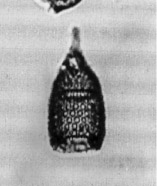 Pterocodon
? anteclinata Foreman
Pterocodon
? anteclinata Foreman Pterocodon
? anteclinata Foreman
Pterocodon
? anteclinata ForemanPterocodon ? anteclinata Foreman, 1975, p.621, pl.9, figs.32-34
Shell small, of four segments, subcylindrical to spindle-shaped. The small subspherical porous cephalis bears a slender, relatively long horn and an upward directed vertical pore. The two post-cephalic segments are smooth without external segmental division and have rounded pores arranged quincuncially in transverse diagonal rows. Only small fragments of the third post-cephalic segment have been observed (Foreman, 1975).
Based on 10 specimens. Length of first three segments including horn 125-140 µm (majority 125-130 µm). Width of abdomen 60-80 µm (majority 60-70 µm) (Foreman, 1975).
Pterocodon ? anteclinata is distinguished from Buryella clinata by possessing a roughened cylindrical horn (rather than a well-developed, heavily ridged bladed horn), which encloses the cephalis at its base. In P.? anteclinata the thorax is subhemispherical and longer than in B. clinata, and the abdomen subcylindrical rather than inflated. It is distinguished from P. ampla in having four segments rather than three, and by not having a distinct internal septum at the lumbar stricture (Sanfilippo, unpubl. data).
Early forms have the horn cylindrical with a roughened blunt tip or roughened overall. This gradually becomes conical, sharper, basally ridged with, in late forms, the ridges beginning to extend onto the cephalis. In late forms also, the thorax becomes relatively shorter and the abdomen more inflated, barrel-shaped. When the horn becomes pointed, completely ridged with well-developed ridges extending down to the base of the cephalis so that the change in contour from the cephalis to the horn is obscure and the abdomen is inflated, barrel-shaped, this species passes over to Buryella clinata (Foreman, 1975).
The morphotypic first appearance of this species lies near the lower limit of the Bekoma campechensis Zone. Its evolutionary transition to Buryella clinata defines the base of the Buryella clinata Zone.